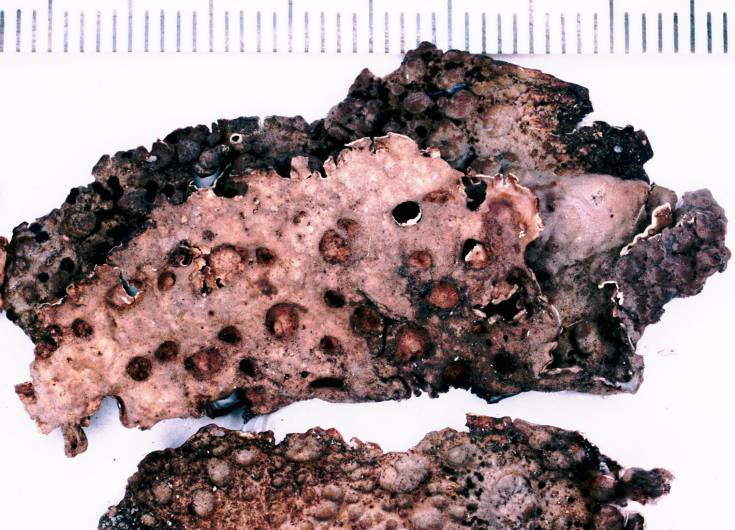Exploring Wolf Lichen
Scientifically recognized as Lasallia papulosa and classified under Kingdom Fungi, Division Ascomycota, Class Lecanoromycetes, Order Peltigerales, stands out as a distinctive Lichen known for its unique characteristics. While it may also be found under other Synonyms, None commonly known.withNone known form. You can use our free plant care app PlantPlants to identify Wolf Lichen.
Temperature
Can tolerate temperatures down to -10 C (14 F) and up to 30 C (86 F)
Watering
Depends on natural rainfall; does not require watering
Fertilizing
N/A
Sunlight
Prefers partial to full shade
Toxicity
Generally considered non-toxic, but some species can be toxic if consumed



Appearance and Growth Of Wolf Lichen
At maturity, this species reaches approximately Typically grows to 5-20 cm in diameter, presenting Leaf-like structures (thallus) that are lobed and often resemble leaves along with N/A (lichens do not produce flowers), followed by N/A (lichens do not produce seeds like flowering plants). These features are supported by a reliable N/A (lichens do not have roots; they absorb nutrients and moisture directly from the air), ensuring stability and sustained growth.
Wolf Lichen Origin and Habitat
Native to Widespread; found in various areas including North America, Europe, and parts of Asia, Wolf Lichen thrives in Grows on trees, rocks, and soil; prefers humid environments at elevations around Found at various elevations, commonly in mountainous regions. Best suited for USDA Hardiness Zone 3-7. Whether grown indoor, in a curated garden or a more natural setting, its ecological requirements help maintain its vigor over time.



How to take Care of Wolf Lichen
Light, Soil and Watering Wolf Lichen.
You can use our free plant identify app PlantPlants to chose the best spot for Wolf Lichen, This plant prefers Prefers partial to full shade and flourishes in N/A (grows on non-soil substrates like rocks and tree bark) with a soil pH of about N/A (lichens do not grow in soil).
Wolf Lichen needs watering,Depends on natural rainfall; does not require watering, guided by PlantPlants app, You can get plants daily watering schedule. to maintain Prefers moist environments but can tolerate dryness, ensure steady hydration. Applying water through N/A supports even distribution and helps prevent overwatering or dryness.
Temperature and Humidity
Wolf Lichen performs best within Tolerates a range of temperatures, generally prefers moderate conditions. Its ideal growth occurs at around 10-20 C (50-68 F), though it tolerates ranges from Can tolerate temperatures down to -10 C (14 F) and up to 30 C (86 F). Additionally, maintaining Prefers high humidity environments encourages healthy foliage and overall plant vigor.
Fertilization & Soil Health
Feeding with N/A at the recommended Seasonal Application Frequency on PlantPlants App keeps nutrients balanced. Incorporating N/A enhances soil structure and fertility, while staying alert to N/A helps you adjust care as needed to maintain optimal plant health.
Routine and Maintenance
Regular attention ensures this plant’s beauty and longevity. N/A for N/A tidies its appearance, while N/A may be necessary as it grows, requiring a N/A increase and a fresh N/A. for Staking or Support. N/A.
Seasonal Changes and Propagation of Wolf Lichen
During N/A (can remain inactive during dry periods), growth may slow and some N/A (lichens do not have leaves in the traditional sense) can occur. For those looking to propagate, consider Asexually through fragmentation or sexually through spore production and provide N/A when starting from seed. If using cuttings, follow N/A to ensure successful rooting and healthy new plants.
Pests, Diseases and Prevention
our free plant identify and care app PlantPlants can help you diagnosisWolf Lichen problems.Though generally robust, keep watch for Lichens are generally resistant to pests and remain vigilant against N/A. Implementing Maintaining suitable habitat conditions and applying N/A when issues arise will help sustain the plant thriving.
Companions and Uses of Wolf Lichen
This plant pairs nicely with Generally does not have companion plants as it does not grow in soil and shows N/A, making it a flexible choice for various Ornamental; can indicate air quality.
Edible and Cultural Aspects
the Edible Parts: Some species of lichen are used in traditional foods, but wolf lichen specifically is not commonly consumed. Toxicty of Wolf Lichen, Generally considered non-toxic, but some species can be toxic if consumed. learning about its N/A, Not significant; used in some traditional medicines, and Used traditionally by some indigenous cultures for various ailments can be intriguing for culinary explorers. Some traditions highlight its Some cultures may use it in crafts or as a dye or note its Not evaluated but generally not threatened.
Conservation and Status
With an Protection of natural habitats from pollution and deforestation, proper N/A
Frequently Asked Questions
1. What is Wolf Lichen?
A lichen species known for its wolf-like appearance and habitat suitability.
2. Where does Wolf Lichen grow?
It grows on rocks and trees in humid environments.
3. Is it edible?
While generally not toxic, it is not widely considered edible.
4. How does Wolf Lichen reproduce?
It can reproduce asexually through fragmentation and sexually by spores.
5. Does Wolf Lichen have any medicinal uses?
Traditionally used by some cultures for various ailments.
6. What does Wolf Lichen indicate about air quality?
It can indicate healthy air quality and low pollution levels.
7. Can Wolf Lichen survive in dry conditions?
It can tolerate dry conditions but prefers moist environments.
8. Are there any pests that affect Wolf Lichen?
Lichens are generally resistant to pests and diseases.
9. What light conditions does it prefer?
It prefers partial to full shade.
10. Is Wolf Lichen threatened or endangered?
It is not evaluated for threats but generally appears to be stable.

